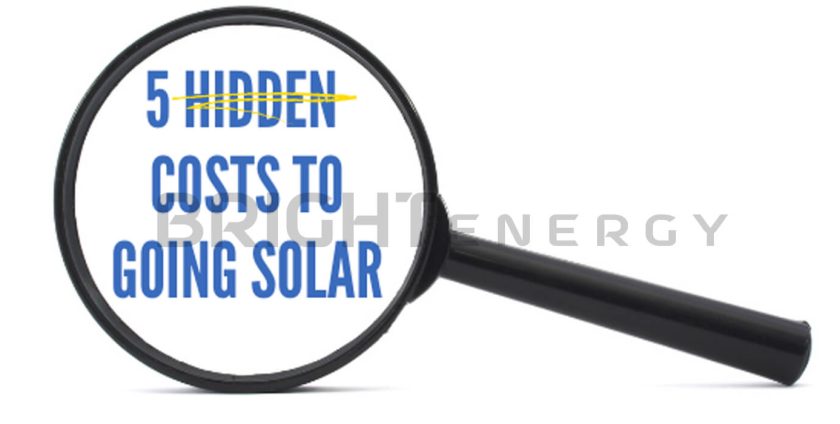
Going solar can be a fantastic investment. Its benefits include lower utility bills, no power shortage, clean and green energy, and easy maintenance. Even after paying a huge cost upfront for the solar power system, the investment in solar power is worth it. People can control their finances and earn by using Net metering.
5 Hidden Costs of Going Solar that You Should
be Aware of
However, it’s essential to be aware of potential hidden costs that can impact your budget. Following are five hidden costs of going solar that you should be aware of:
Roof Repairs or Replacements:
Before installing solar panels, a thorough assessment of your roof’s condition is necessary. If your roof is old or in poor condition, it might not be able to support the weight of solar panels. In such cases, you would need to repair or reinforce your roof, adding costs that might not have been initially anticipated.
Installing solar panels on a damaged roof can void the roof’s warranty. If you install solar panels without repairing the roof first, and later your roof experiences issues, the manufacturer’s warranty might not cover the repairs due to the presence of the solar panels. This situation could lead to unexpected costs.
Certain roof types or structures can present challenges during solar panel installation. For instance, if your roof has a complex design, multiple levels, or obstructions like chimneys, additional work might be required to properly install the panels. These challenges can result in higher installation costs. Make sure the roof is leveled to increase the productivity.
If parts of your roof are shaded by nearby trees or buildings, it might affect the efficiency of your solar panels. In such cases, installing extra equipment like micro-inverters or optimizers to mitigate shading issues can increase costs. Additionally, if shading issues are due to overhanging branches, the need to trim or remove these branches could incur additional expenses.
Sometimes, during the installation process, minor damages can occur to the roof. While professional installers take precautions, accidents can happen, leading to the need for repairs. These damages might not be covered by the solar panel installation warranty, resulting in unexpected costs for repairing the roof.
Upfront Installation Costs:
While solar energy systems can save you money in the long run, the initial installation cost can be high. Some companies might provide low upfront costs, but these could be offset by higher long-term contracts. Make sure you understand the total installation cost and compare quotes from multiple providers. Another tip is to ask for installments from the providers.
Maintenance and Repairs:
Solar panels are generally low-maintenance, but they aren’t maintenance-free. Inverters, batteries (if you’re using them), and other components may require repairs or replacements over time. Additionally, you may need occasional professional cleaning to maintain the efficiency of your panels. These ongoing maintenance costs can add up over the years.
Hidden Installation Challenges:
Sometimes, additional equipment might be required based on your specific energy needs or the layout of your property. This can include items like optimizers or micro-inverters, especially if your solar panels will be installed in areas with shading issues. These extra components add to the installation cost but might not always be included in the initial quote.
Your existing electrical system might need upgrades to accommodate the solar panels. This can include upgrading your electrical panel to handle the extra load or rewiring certain parts of your house. Such upgrades are essential for safety and functionality but can be an additional cost.
Obtaining permits and inspections from local authorities is often necessary for solar panel installation. The fees associated with these permits and inspections can vary based on your location and might not be explicitly stated in the initial quote.
If you’re connecting your solar system to the grid for net metering purposes (where excess energy is sent back to the grid), there might be fees associated with connecting your system to the grid. These fees can vary by utility provider and might not be included in the initial quote.
Depending on your property, there could be site preparation work needed, such as tree removal, ground leveling, or structural assessments. These costs are often site-specific and might not be part of the standard installation quote.
Permitting and Inspection Fees:
Installing solar panels often requires permits and inspections from local authorities. These processes come with fees that are sometimes overlooked when budgeting for a solar project. The cost and complexity of permits can vary widely depending on your location, so it’s essential to research local regulations and factor these fees into your budget.
Before committing to solar energy, it’s crucial to get multiple quotes from reputable solar providers, understand the warranties and maintenance costs, and be aware of all the potential expenses involved. This way, you can make an informed decision about whether solar energy is the right choice for your home or business. Contact Bright Energy for reasonable rates of solar power systems where every cost will be told in detail before installing the system.

Leave a Reply